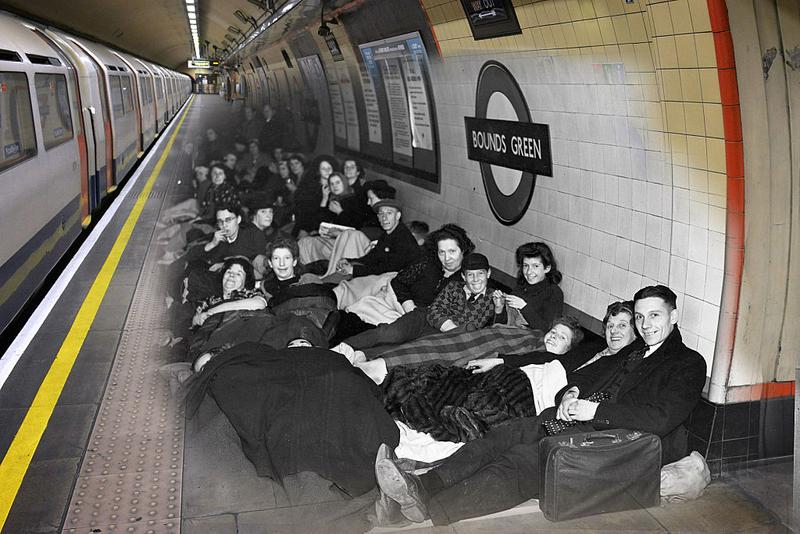London Blitz: Photos From When Germany Attacked London
By | December 5, 2020

For more than eight months of World War II, London was the target of relentless air raid attacks by German bombers. Although the bombing campaign—called the London Blitz, after the German word of "lightning"—was intended to wear down the morale of Londoners and force them to withdraw their troops, the Germans greatly underestimated the resilience of the British people. They quickly and effectively adopted measures to protect their children and stay safe during the destruction.

A Blitz On London And Beyond
Although London was the primary target of the German bombers, it wasn't the only part of England on the receiving end of German bombs. Cities and towns all along the English coast (including Cardiff, Bristol, Plymouth, and Portsmouth) were also hit with air raid attacks. Industrial cities further north that housed the factories that made goods for the war effort (such as Manchester, Coventry, and Birmingham) also saw their share of Blitz attacks.



Death And Destruction
The Blitz attacks killed roughly 40,000 British civilians between September 7, 1940 and May 11, 1941, half of them in London. More than a million homes were either completely destroyed or heavily damaged, while roads, bridges, and railways were left in ruins.


The Brits Were Prepared
Even though the German air attacks were not expected, the Brits were prepared. Their early warning radar system was the most advanced of its kind in the world and gave their military enough advance warning of incoming German bombers that citizens had time to seek shelter. The Royal Air Force also had two models of fighter planes, the Spitfire and the Hurricane, that were superior to the German bombers. With this firepower under their belt, they shot down several of the incoming bombers.

Evacuation Orders
The British government, having witnessed air raid attacks on the city of Guernica during the Spanish Civil War, had already established evacuation plans in case London was ever attacked. When the bombings began, the British government evacuated about 1.5 million civilians, most of them children, from target cities like London and Portsmouth to the relative safety of small, rural villages.

Air Raid Shelters
Using corrugated steel reinforcements, the Department of Air Raid Precautions oversaw the installation of more than two million air raid shelters. While these shelters offered a degree of protection from the German bombs, they were cramped, cold, damp, and they lacked the creature comforts residents were used to.

Safety Underground
In general, it was safer to be underground when the bombs hit. People who were fortunate enough to have basements (a rarity in London) could hide out there, but others were forced into public areas such as tunnels and underground rail stations. The raids were often short lived, so citizens could soon depart and resume their normal activities, but families who were left homeless by the attacks often adopted the underground shelters as makeshift homes.



Communal Shelters
At first, officials discouraged citizens from holing up in the London Underground because they didn't want the crowds to interfere with the trains, but they soon relented. Roughly 150,000 people slept in the London Underground every night. Buckling under public demand, officials agreed to expand the Underground to house an additional 80,000 people, but by the time the work was done, the Blitz was over.

Operation Pied Piper
To protect the children of London from the Blitz, the British military launched Operation Pied Piper. Schoolteachers around the country were tasked with chaperoning millions of children who were separated from their parents and sent out of urban centers to hide in the English countryside. The youngsters wore documents around their necks on lanyard-type chains similar to dog tags with the information needed to reunite them with their families after the war.

Gas Masks: The New Normal
The British government feared German bombers would drop chemical weapons on London and other English cities during the Blitz, as had been alarmingly common in the First World War, so they issued gas masks to every citizen. The rubber masks were stiflingly hot, cumbersome, stinky, and difficult to breathe through, but the British public had no choice but to comply. The insidious nature of gases like mustard gas, which could go undetected for up to 12 hours before it took effect, led officials to mandate gas mask usage in all public areas under penalty of fines.






Spirit And Fortitude
By most accounts, the London Blitz was not as devastating as the British military anticipated. In fact, the campaign is considered a German failure. For the no-nonsense Brits, the Blitz was an inconvenience, but they continued on with their lives, blithely referring to certain days as "rather blitzy." The atmosphere at communal air raid shelters was often jovial and cheerful, and incidents of suicide and drunkenness actually went down during the Blitz. The British people pulled together and got through the Blitz with a remarkable sense of fortitude, patriotism, and comradery.

